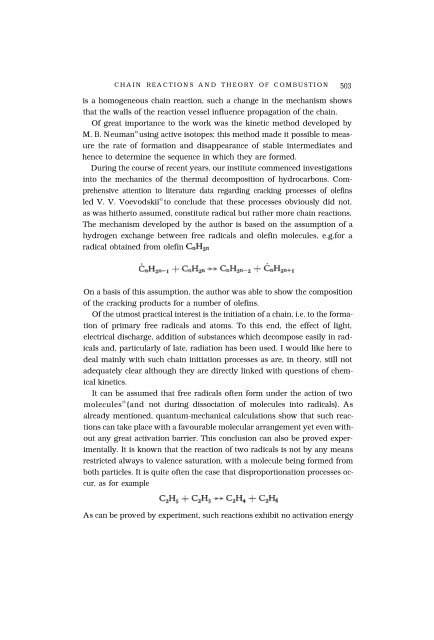Nikolai N. Semenov - Nobel Lecture - Nobelprize.org
Nikolai N. Semenov - Nobel Lecture - Nobelprize.org
Nikolai N. Semenov - Nobel Lecture - Nobelprize.org
You also want an ePaper? Increase the reach of your titles
YUMPU automatically turns print PDFs into web optimized ePapers that Google loves.
CHAIN REACTIONS AND THEORY OF COMBUSTION 503<br />
is a homogeneous chain reaction, such a change in the mechanism shows<br />
that the walls of the reaction vessel influence propagation of the chain.<br />
Of great importance to the work was the kinetic method developed by<br />
M. B. Neuman 42 using active isotopes; this method made it possible to measure<br />
the rate of formation and disappearance of stable intermediates and<br />
hence to determine the sequence in which they are formed.<br />
During the course of recent years, our institute commenced investigations<br />
into the mechanics of the thermal decomposition of hydrocarbons. Comprehensive<br />
attention to literature data regarding cracking processes of olefins<br />
led V. V. Voevodskii 43 to conclude that these processes obviously did not,<br />
as was hitherto assumed, constitute radical but rather more chain reactions.<br />
The mechanism developed by the author is based on the assumption of a<br />
hydrogen exchange between free radicals and olefin molecules, e.g.for a<br />
radical obtained from olefin &Han<br />
On a basis of this assumption, the author was able to show the composition<br />
of the cracking products for a number of olefins.<br />
Of the utmost practical interest is the initiation of a chain, i.e. to the formation<br />
of primary free radicals and atoms. To this end, the effect of light,<br />
electrical discharge, addition of substances which decompose easily in radicals<br />
and, particularly of late, radiation has been used. I would like here to<br />
deal mainly with such chain initiation processes as are, in theory, still not<br />
adequately clear although they are directly linked with questions of chemical<br />
kinetics.<br />
It can be assumed that free radicals often form under the action of two<br />
molecules 35 (and not during dissociation of molecules into radicals). As<br />
already mentioned, quantum-mechanical calculations show that such reactions<br />
can take place with a favourable molecular arrangement yet even without<br />
any great activation barrier. This conclusion can also be proved experimentally.<br />
It is known that the reaction of two radicals is not by any means<br />
restricted always to valence saturation, with a molecule being formed from<br />
both particles. It is quite often the case that disproportionation processes occur,<br />
as for example<br />
As can be proved by experiment, such reactions exhibit no activation energy
















